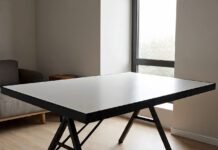Table of Contents
Flat Roof Replacement Cost
Replacing a flat roof is a significant investment for any homeowner or property manager. Understanding the costs involved, the available materials, labor expenses, and the expected lifespans of different roofing types can help you make informed decisions.
Flat roofs are a popular choice for both commercial buildings and modern residential homes. Known for their sleek design, ease of access, and space efficiency, they offer a practical alternative to pitched roofs.
However, unlike sloped roofs, flat roofs require specific materials and expertise to ensure proper drainage and durability. This comprehensive guide will walk you through everything you need to know about flat roof replacement costs.
| Material | Cost per Square Foot | Lifespan | Advantages | Disadvantages | Estimated Total Cost (1,500 sq ft) |
| EPDM | $4 – $8 | 20 – 30 years | Durable, UV-resistant | Can be punctured | $8,250 – $17,250 |
| TPO | $5 – $10 | 15 – 25 years | Energy-efficient, lightweight | Seams can be vulnerable | $9,750 – $20,250 |
| PVC | $6 – $12 | 20 – 30 years | Fire-resistant, strong | Higher initial cost | $11,250 – $23,250 |
| Built-Up Roofing | $5 – $10 | 15 – 30 years | Robust, good waterproofing | Heavy, can be prone to leaks | $9,750 – $20,250 |
| Modified Bitumen | $4 – $8 | 15 – 20 years | Flexible, easy to repair | Can be less durable than other options | $8,250 – $17,250 |
Understanding Flat Roofs

Flat roofs are characterized by their low slope, typically 1% to 10%. They are commonly found in commercial buildings but are also becoming increasingly popular in residential homes due to their modern aesthetic and practicality.
Flat roofs offer various benefits, such as additional outdoor living space and easier maintenance access. However, they also come with unique challenges, particularly regarding drainage and potential leaks.
Factors Influencing Flat Roof Replacement Costs
Several factors influence the overall cost of replacing a flat roof, including:
1. Roofing Material
The choice of roofing material is one of the most significant factors affecting replacement costs. Different materials vary in price, durability, and maintenance requirements.
2. Size of the Roof
The total area requiring replacement will directly affect the cost. Larger roofs will naturally incur higher material and labor expenses.
3. Labor Costs
Labor costs can vary by geographic location, installation complexity, and contractor experience. In areas with a high demand for roofing services, labor costs may be higher.
4. Removal of Old Roofing
If the old roof needs to be removed, it will increase the overall cost. Proper disposal of materials and potential repairs to underlying structures may also be necessary.
5. Accessibility
If the roof is difficult to access or requires special equipment, this can increase labor costs.
Common Flat Roofing Materials

1. EPDM (Ethylene Propylene Diene Monomer)
- Description: EPDM is a synthetic rubber material known for its durability and resistance to UV rays and harsh weather conditions.
- Cost: Approximately $4 to $8 per square foot.
- Lifespan: 20 to 30 years.
2. TPO (Thermoplastic Olefin)
- Description: TPO is a single-ply roofing membrane that is energy-efficient and resistant to UV damage. It is lightweight and easy to install.
- Cost: Approximately $5 to $10 per square foot.
- Lifespan: 15 to 25 years.
3. PVC (Polyvinyl Chloride)
- Description: PVC roofing is known for its strong resistance to water, fire, and chemicals, making it suitable for a variety of settings.
- Cost: Approximately $6 to $12 per square foot.
- Lifespan: 20 to 30 years.
4. Built-Up Roofing (BUR)
- Description: BUR consists of multiple layers of asphalt and reinforcing fabrics, providing a robust and durable roofing system.
- Cost: Approximately $5 to $10 per square foot.
- Lifespan: 15 to 30 years.
5. Modified Bitumen
- Description: Modified Bitumen is an evolution of BUR, featuring asphalt and polymer additives for improved flexibility and durability.
- Cost: Approximately $4 to $8 per square foot.
- Lifespan: 15 to 20 years.
Comparison of Flat Roofing Materials

| Material | Cost per Square Foot | Lifespan | Advantages | Disadvantages |
| EPDM | $4 – $8 | 20 – 30 years | Durable, UV-resistant | Can be punctured |
| TPO | $5 – $10 | 15 – 25 years | Energy-efficient, lightweight | Seams can be vulnerable |
| PVC | $6 – $12 | 20 – 30 years | Fire-resistant, strong | Higher initial cost |
| BUR | $5 – $10 | 15 – 30 years | Robust, good waterproofing | Heavy, can be prone to leaks |
| Modified Bitumen | $4 – $8 | 15 – 20 years | Flexible, easy to repair | Can be less durable than other options |
Labor Costs for Flat Roof Replacement
Labor costs for flat roof replacement can vary based on several factors:
- Geographic Location: Labor rates differ from one region to another. Urban areas typically have higher labor costs than rural areas.
- Complexity of Installation: Roofs with multiple levels, features, or difficult access points may require more labor, increasing costs.
- Experience of the Contractor: Skilled and reputable contractors may charge more for their expertise, but this can lead to better results and fewer issues down the road.
On average, homeowners can expect to pay between $1.50 $3.50 per square foot for labor, depending on the factors mentioned above.
Additional Costs to Consider

1. Removal and Disposal of Old Roofing
Removing the existing roof can add significant costs, typically ranging from $1 to $3 per square foot, depending on the material and the complexity of removal.
2. Underlayment and Insulation
If the existing underlayment is damaged or inadequate, you may need to replace it, which can add another $0.50 to $2 per square foot. Insulation improvements can further increase costs, but can enhance energy efficiency.
3. Roof Accessories
Additional components such as flashing, vents, and drainage systems can also affect the total cost. These accessories typically range from $100 to $500 each, depending on the type and complexity.
4. Warranty Costs
Many roofing materials come with warranties, but extended warranties can add to the initial cost. Be sure to factor this into your budget.
Total Estimated Costs for Flat Roof Replacement
To give you a clearer picture, here’s a breakdown of the estimated total costs for replacing a flat roof based on different materials and a typical roof size of 1,500 square feet.
| Material | Material Cost | Labor Cost | Total Estimated Cost |
| EPDM | $6,000 – $12,000 | $2,250 – $5,250 | $8,250 – $17,250 |
| TPO | $7,500 – $15,000 | $2,250 – $5,250 | $9,750 – $20,250 |
| PVC | $9,000 – $18,000 | $2,250 – $5,250 | $11,250 – $23,250 |
| BUR | $7,500 – $15,000 | $2,250 – $5,250 | $9,750 – $20,250 |
| Modified Bitumen | $6,000 – $12,000 | $2,250 – $5,250 | $8,250 – $17,250 |
Lifespan of Flat Roofing Materials
Understanding the lifespan of different roofing materials is crucial for long-term planning. Here’s a summary of the expected longevity for each material:
- EPDM: 20 to 30 years
- TPO: 15 to 25 years
- PVC: 20 to 30 years
- BUR: 15 to 30 years
- Modified Bitumen: 15 to 20 years
Importance of Regular Maintenance

Regular maintenance is key to extending the lifespan of your flat roof. Here are some essential maintenance tips:
- Inspect Regularly: Conduct visual inspections at least twice a year and after severe weather events.
- Clean Gutters and Drains: Ensure that gutters and drainage systems are free from debris to prevent water pooling.
- Address Issues Promptly: Repair any damage or leaks as soon as they are noticed to prevent further deterioration.
- Professional Inspections: Consider hiring a professional to assess the roof’s condition every few years.
Conclusion
Replacing a flat roof is a significant investment that requires careful consideration of factors such as material choices, labor costs, and maintenance. By understanding the costs of different roofing types, their expected lifespans, and the importance of regular maintenance, you can make informed decisions that will protect your investment for years to come.
Whether you opt for EPDM, TPO, PVC, BUR, or modified Bitumen, working with a qualified contractor will help you achieve a durable, efficient roofing solution that meets your needs. With proper planning and maintenance, your new flat roof can provide reliable protection and enhance your property’s value.
FAQs
Key factors include roofing material, roof size, labor costs, removal of old roofing, and roof accessibility.
While DIY is possible, it is generally recommended to hire a professional to ensure proper installation and warranty coverage.
Regular inspections, debris removal, and prompt repair of any leaks or damage are essential for maintaining a flat roof.
Consider factors such as cost, lifespan, climate, and specific roofing needs when selecting the best material for your flat roof.
















